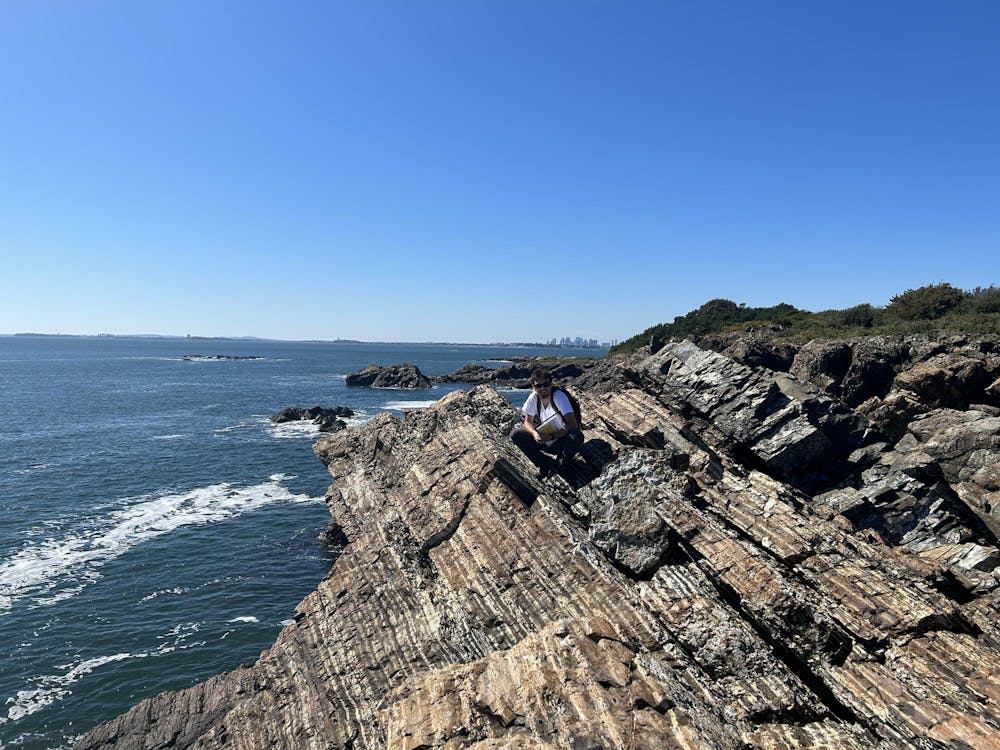Armed with waterproof notebooks and an “underlying assumption that things are worth investigating,” students in a new geology course at the University are traveling to the far edges of Rhode Island to observe, measure and map rocks, according to Eben “Blake” Hodgin, assistant professor of earth, environmental and planetary sciences.
EEPS 1250: “New England Field Geology” is teaching hands-on fieldwork skills to 11 students over the course of nine field trips during the semester. Taught by Hodgin, the class is open to both undergraduate and graduate students.
The course covers a range of geological topics and how they can reveal the history of New England, Hodgin said. A field trip to Narragansett Pier in southern Rhode Island emphasized granite outcrops, and a trip to Nahant, Massachusetts exposed students to rock structures that contain evidence of some of the earliest fossils. An upcoming field trip to Block Island, southwest of Newport, will allow students to study deformed Pleistocene glacial strata.
“There’s a lot of folks who, if they're out there and they can make an observation that resonates with them, then it’ll stick with them,” Hodgin said, speaking to the importance of fieldwork.
The central purpose of developing hands-on skills for geological fieldwork caught the interest of Kaiyuan Wang GS, a first-year graduate student in the Department of Earth, Environmental and Planetary Sciences.
“Textbooks become tangible,” Wang said. “You can apply what you learn from a textbook, from classroom settings, into the real world and it equips you with knowledge to read rocks, to interpret landforms (and) to really know the physical environment that shapes human society.”
The primary field skill of the class is geological mapping — the sometimes-challenging process of labeling rock types and formations — Hodgin said. The course also fosters an awareness of surroundings and problem-solving skills that can be applied to an array of careers in the geoscience field, such as environmental consulting.
“A lot of people who take this class aren't going to end up making geologic maps (for) a living, so a lot of it is trying to develop skills that are used for other things,” said Isaiah Olds-Campanile ’24, the course’s teaching assistant. “Being able to go out in the field and identify properties of things and how they behave can be applied” to other professions.
“New England Field Geology” is not the only class on campus based around field trips. BIOL 0940D: “Rhode Island Flora: Understanding and Documenting Local Plant Diversity” also takes students to different sites across the Ocean State.
This type of hands-on study “gives students a different window into why they may or may not want to be a scientist,” said Will Malloy ’25, the BIOL 0940D teaching assistant.
But because space in these courses is limited and terrain is often physically inaccessible, the opportunity for this hands-on experience might be exclusive, Malloy pointed out.
For those who do get to experience it, the geology of New England is a “hidden gem,” Olds-Campanile said.
The region has many distinctive, unique features, “even if it doesn’t hit you in the face as much as the Grand Canyon or the Sierras,” Hodgin said. It takes “a little more imagination to fully appreciate some of the geology.”
One unique feature of New England the course investigates is evidence of the Great Unconformity, a period of time missing in the rock record, along the Appalachian Trail. Another process preserved in the region is the Wilson Cycle, which describes the openings and closings of oceans during the assembly and disassembly of supercontinents.
Hodgin and Olds-Campanile worked together over the summer to put together the course syllabus and select field trip sites. The pair narrowed the options to the final nine on the syllabus after visits to numerous sites and input from professors at other universities in the area.
The terrains carry a certain degree of danger, Hodgin said. Wang recalled falling into a river when a branch he was holding onto broke, but he treats “this little injury as a mark of honor.”
The recent rainy weather hasn’t helped. “Once we go into the middle of woods, with a heavy layer of organic debris, it’s kind of not too nice to walk on if it’s soaked in water, full of earthworms,” Wang said. “The soil is slippery. By the end of the day, most people have their socks soaked.”
Squelchy socks aside, Wang said knowing about his surroundings has helped him better enjoy them.
“Before moving down to Rhode Island and Providence, I was thinking ‘Wow, I'm gonna move to a boring place. The state is so flat, so boring,’” he said.
But the class has changed Wang’s mind.
“Now, when I go out — even if it's a little bit flat — if I see a rock, I can read the history of the rock,” he said. “It's like a good book. I know what has happened in this place in the past, hundreds of millions of years ago. And that aspect of the course, of learning about Earth history in New England, makes me better appreciate this place.”

Elise Haulund is a science & research editor and sophomore from Redondo Beach, CA. Concentrating in English and biology, she has a passion for exploring the intersection between STEM and the humanities. Outside of writing, researching and editing, she enjoys ballet-dancing, cafe-hopping and bullet-journaling.





